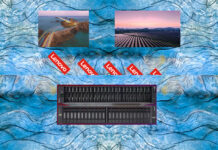Some Seagate Barracuda Compute and Desktop disk drives use shingled magnetic recording (SMR) technology which can exhibit slow data write speeds. But Seagate documentation does not spell this out.
Yesterday we reported Western Digital has submarined SMR drives into certain WD Red NAS drives. The company acknowledged this when we asked but it has not documented the use of SMR in the WD Red drives. This has left many users frustrated and speculating for the reason why the new drives are not working properly in their NAS set-ups. Since this article was first published Toshiba has also confirmed the undocumented use of SMR in some desktop hard drives.
Geizhals, a German-language price comparison website, lists seven Seagate SMR drives.
- Barracuda 2TB – 7,200rpm – SATA 6gig – model name – ST2000DM008
- Barracuda 4TB – 5,400rpm – SATA 6gig – ST4000DM004
- Barracuda 8TB – 5,400rpm – SATA 6gig – ST8000DM004
- Desktop HDD 5TB – 5,900rpm – SATA 6gig – ST5000DM000
- Exos 8TB – 5900rpm – SATA 6gig – ST8000AS0003
- Archive v2 6TB – 5,900rpm – SATA 6gig – ST6000AS0002
- Archive v2 8TB – 5,900rpm – SATA 6gig – ST8000AS0002
Public Seagate documentation for these Barracudas and the Desktop HDD do not mention SMR. For example,
- The Barracuda 8TB (ST8000DM004) data sheet does not mention SMR.
- The Barracuda 8TB (ST8000DM004) product manual does not mention SMR.
- A 5TB Desktop HDD (ST5000DM000) product manual does not mention SMR.
The Archive drives are for archiving and Exos drives are optimised for maximum storage capacity and the highest rack-space efficiency. Seagate documentation for the Exos and Archive HDDs explicitly spells out that they use SMR.
Seagate markets the Barracuda Compute drives as fast and dependable. Yet it is the nature of SMR drives that data rewrites can be slow.
When we asked Seagate about the Barracudas and the Desktop HDD using SMR technology, a spokesperson told us: “I confirm all four products listed use SMR technology.”
In a follow-up question, we asked why isn’t this information is not explicit in Seagate’s brochures, data sheets and product manuals – as it is for Exos and Archive disk drives?
Seagate’s spokesperson said: “We provide technical information consistent with the positioning and intended workload for each drive.”
Update
Seagate issued this statement on April 21: “Seagate confirms that we do not utilize Shingled Magnetic Recording technology (SMR) in any IronWolf or IronWolf Pro drives – our NAS solutions family. Seagate does not market the BarraCuda family of products as being suitable for NAS applications, and does not recommend using BarraCuda drives for NAS applications. Seagate always recommends to use the right drive for the right application.”
Why SMR drives are sub-optimal for write-intensive workloads
Shingled magnetic recording gets more data to disk plates by partially overlapping write tracks, leaving the read track within them clear. Read IO speed is unaffected but data rewrites requires blocks of tracks to be read edited with the new data and rewritten as a new block. This lengthens data rewrite time substantially compared with conventionally recorded drives.
Write-intensive workloads are worse affected by SMR delays than read-intensive workloads. Therefore SMR drives are typically used for archival-type applications and not for real-time mixed or route-intensive use cases.
Caching writes to a non-shingled zone of the drive and writing them out to the shingled sectors in idle time will hide the slow rewrite speed effectively – until the cache fills when rewrite IO requests are still coming in.
The cache is then flushed and all the data written to the shingled area of the drive, causing a pause of potentially many seconds while this is done.







